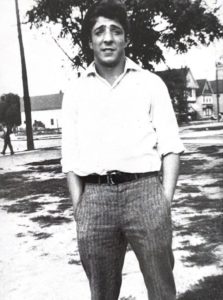Michael DeCapite
(1915–1958), whose early death in a car accident at the age of 42 ended what
Fred Gardaphé, the foremost scholar of Italian American literature, says was “proving to be a prominent career as an American novelist.” The New York Times called his first novel Maria (1943) “a remarkably well-written book . . . in a style that is melodiously warm and unmannered.” He used his own experiences growing up in the Cleveland neighborhood overlooking the industrial valley now known as Tremont to illuminate the lives of Italian-American immigrants confronting Americanization and assimilation. Another reviewer called DeCapite’s novel “an important and sobering book.”
While Maria is “charged with passion,” said the reviewer, “ its rhythm remains collected, even serene, like the skies in early Renaissance paintings.” (DeCapite’s debut novel seems even to have attracted the attention of Hollywood, as one copy found for sale on line bears the label of the Myron Selznick & Company agency and is rubber-stamped “Property of Vanguard Films, Inc.,” having been passed on, in other words, to Myron’s brother, producer and screenwriter David O.)

DeCapite in Lincoln Park: When Tremont was still just “The
South Side” (Photo used with the permission of the DeCapite family)
Cleveland literary historian Rose Mary Prosen found “DeCapite’s descriptions of Cleveland’s Central Market, Little Italy, the South Side, the city, the Flats . . . the Italian festas, the factory life, the immigrant characters, their conversations, their struggles, their dreams . . . vigorous and moving and controlled. Death and disaster and humor and grace unfold in the pages of a book that makes no moral judgments, that condemns no one, that asks for no pity. Maria is a novel of human struggle, of the human condition, perhaps multiplied in its complexity because the characters have transplanted themselves from Abruzzi, Italy, to Cleveland, Ohio, to find that ambition and greed and love and hate and compassion and grace know no national boundaries.” The setting of his second novel, No Bright Banner (1944), would be Cleveland’s steel mills.
Seeing chunks of Maria as a work-in-progress (as early as 1940) seems to have been what impressed several leading American social thinkers enough to commission a piece by DeCapite for the inaugural issue of Common Ground, an ahead-of-its time quarterly (1940–1949) founded by Louis Adamic “to tell and discuss one of the greatest stories under the sun—the story of the coming and meeting in America of people belonging to three score different national, racial and religious backgrounds.”
On the cover of that first issue 25-year-old Michael DeCapite’s name appears in the distinguished company of such respected figures as historian Arthur Schlesinger, esteemed literary historian Van Wyck Brooks and poet John Ciardi. That legendary journal was to publish an insightful article by DeCapite titled “The War Comes to Little Italy” as well as an excerpt from a novel-in-progress. Given his interests, he must have been ecstatic when, in 1947, he was offered a staff position as information officer at the newly formed UN.
The following year, his third novel, The Bennett Place (1948), won praise from The San Francisco Chronicle, New York Herald Tribune, The Christian Science Monitor and The New Statesman; and DeCapite was chosen Novelist of the Year by the Chicago-based Friends of American Writers. Though currently out of print, his novels are all in the collection of the Cleveland Public Library.
An interesting footnote: His younger brother Raymond, another fine, nationally praised, novelist, would become the second writer to receive the Cleveland Arts Prize in 1962.) In fact, a “fascinating comparative study” could be made between Michael’s Maria and Raymond’s The Coming of Fabrizze, writes Edward Ifkovic in The Birth of Modern Cleveland, 1865–1930, “as the brothers have taken the same autobiographical material as the basis for their respective first novels. (Ray actually appears in the earlier novel as one of the three children.)
“Their father was indeed an Italian immigrant who came to America at the age of twelve, became foreman of a railroad gang in Cleveland, pursued the American Dream with a vengeance, lost everything in the stock market, left his family, and so on.” But while Ray, only a little boy at the time of these events, “came to see the playing out of his father’s destiny”—after a visit the brothers made to the village their father had left as a youth “aflame with ambition and hope”—in the light of “a larger story.”
As the older brother, Michael had watched that story play out in the context of a family struggling to realize the immigrant’s dream.